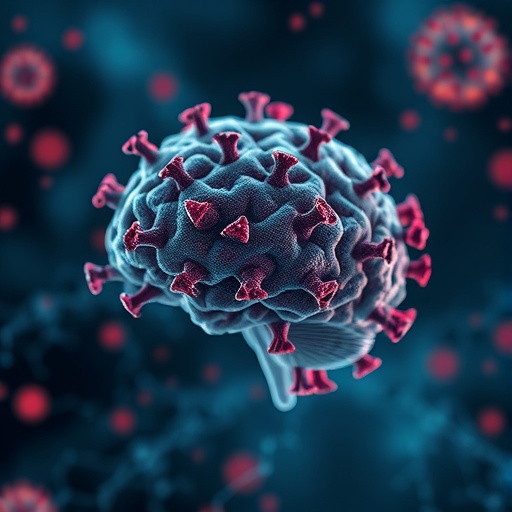In the years following the onset of the COVID-19 pandemic, understanding the long-term consequences of SARS-CoV-2 infection remains a pressing scientific and medical challenge. Among these, Long COVID—a complex chronic condition presenting a myriad of persistent symptoms after initial infection—has emerged as one of the most perplexing sequelae. Central to the experience of many suffering from Long COVID is the debilitating cognitive impairment commonly dubbed “brain fog.” Affecting more than 80% of individuals with Long COVID, this syndrome manifests as profound difficulties in memory, concentration, and overall mental clarity, severely disrupting daily functioning and quality of life on a global scale.
Despite the high prevalence and significant impact of Long COVID brain fog, the molecular underpinnings responsible for this cognitive dysfunction have remained elusive. Previous neuroimaging endeavors primarily revealed macroscopic structural alterations within the brain but failed to illuminate the specific neurochemical or receptor-level changes that directly contribute to cognitive deficits. This knowledge gap has hampered efforts to develop objective diagnostic biomarkers or targeted therapies that could alleviate brain fog symptoms. The complexity arises from the difficulty in directly visualizing key neurotransmitter receptors in the living human brain, a challenge that has limited direct assessment of synaptic molecular dysfunction in these patients.
Addressing these critical unknowns, a pioneering research group headed by Professor Takuya Takahashi at the Graduate School of Medicine, Yokohama City University, has made a landmark breakthrough in deciphering the molecular basis of Long COVID brain fog. Their research, recently published in the prestigious journal Brain Communications, leveraged cutting-edge positron emission tomography (PET) imaging with a novel tracer known as [^11C]K-2 to directly visualize and measure the density of AMPA-type glutamate receptors (AMPARs) in vivo. AMPARs play an essential role in fast excitatory neurotransmission and are fundamental to synaptic plasticity, learning, and memory—processes severely compromised in Long COVID patients.
By comparing PET scans from 30 subjects afflicted with Long COVID to 80 healthy controls, the investigators uncovered a striking and widespread increase in AMPAR density throughout multiple brain regions of affected individuals. Crucially, the degree of this receptor upregulation exhibited a robust correlation with the severity of cognitive impairment observed clinically. The data unmistakably establish a link between abnormal synaptic receptor expression and the cognitive symptoms characteristic of Long COVID brain fog, providing the first molecular biomarker connecting brain function alterations with clinical presentation.
Further examination revealed concomitant elevations in systemic inflammatory biomarkers tightly associated with AMPAR density increases, implicating a synergistic interaction between immune dysregulation and synaptic receptor remodeling. This connection offers a plausible mechanistic explanation for how persistent inflammation triggered by SARS-CoV-2 infection could drive maladaptive molecular changes within neural circuits, ultimately manifesting as cognitive dysfunction. These insights highlight the inflammatory milieu’s role in shaping neurotransmitter receptor populations and suggest inflammation-targeted interventions may complement receptor-focused therapies.
The implications of these findings are profound, as they redefine Long COVID brain fog as a biologically verifiable disorder with measurable molecular abnormalities rather than a nebulous symptom complex. The identification of AMPAR overexpression opens new avenues for therapeutic development, including the potential use of AMPAR antagonists—drugs capable of normalizing excessive receptor activity—to reverse or mitigate cognitive deficits. Moreover, the ability of PET imaging with [^11C]K-2 to distinguish Long COVID patients from healthy individuals with exceptional sensitivity (100%) and high specificity (91%) underscores its promise as a diagnostic tool for objectively confirming brain fog associated with Long COVID.
Professor Takahashi emphasizes the transformative nature of this approach, stating that applying advanced AMPAR PET imaging technology furnishes researchers and clinicians with a novel perspective and innovative solutions to the urgent medical challenge posed by Long COVID. While comprehensive treatments remain forthcoming, this study constitutes a pivotal step toward precision medicine strategies tailored to the molecular pathology of Long COVID brain fog.
Looking ahead, further research aimed at longitudinally monitoring AMPAR dynamics and inflammatory profiles in Long COVID patients may elucidate progression patterns and identify critical windows for therapeutic intervention. Integrating molecular imaging biomarkers with clinical phenotyping can refine patient stratification and accelerate the development of targeted pharmaceuticals aimed at synaptic receptor regulation and immune modulation.
The groundbreaking revelation that excessive AMPA receptor expression underpins cognitive impairment in Long COVID not only advances scientific understanding but also lends legitimacy and clarity to patients’ experiences. Recognizing Long COVID brain fog as an authentic neurological disorder with definable pathophysiology is crucial for galvanizing healthcare systems, regulatory agencies, and pharmaceutical companies to intensify efforts in diagnostic and treatment innovations.
This comprehensive study thus bridges a critical knowledge gap, shedding light on the complex neurobiological interplay between viral infection, immune response, and synaptic function disruption. The utilization of an innovative molecular brain imaging technique has unveiled concrete biological targets and offered a potential biomarker set that could revolutionize Long COVID research and clinical management worldwide.
In summary, the research led by Professor Takahashi and his colleagues constitutes a watershed moment in combating one of the most challenging facets of the COVID-19 pandemic’s legacy. By pinpointing a systemic increase in AMPA receptors tied to cognitive decline, this investigation lays the foundation for novel diagnostic tools and therapeutic strategies that could dramatically improve outcomes for millions suffering from Long COVID brain fog across the globe. Through continued multidisciplinary collaboration and technological innovation, hope is on the horizon to unravel and ultimately resolve this enigmatic post-viral syndrome.
Subject of Research: People
Article Title: Systemic increase of AMPA receptors associated with cognitive impairment of Long COVID
News Publication Date: 1-Oct-2025
Web References: https://doi.org/10.1093/braincomms/fcaf337
References: Takahashi, T., et al. (2025). Systemic increase of AMPA receptors associated with cognitive impairment of Long COVID. Brain Communications. DOI: 10.1093/braincomms/fcaf337
Image Credits: Professor Takuya Takahashi from Yokohama City University
Keywords: COVID 19, Neurology, Brain, Imaging, Cognitive neuroscience, Biomarkers, Diseases and disorders, Molecular biology, Public health, Medical treatments




